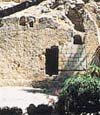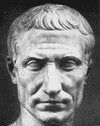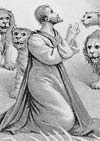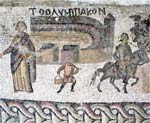
Discuss the world's favourite imaginary friend on the JNE YouTube channel
Logical fallacies and semantic trickery are the very essence of Christian apologetics, exploiting a general ignorance of science and responding to the desire for quick-fix salvation and something easy on the brain cells.
Find the Jesus!
Liar, Madman or Son of God? – The Apologist's trickster challenge.
Try "never existed at all"!
A Professor Speaks..
"Multiple attestation?
This argument is valueless since the evangelists demonstrably shared so much material from common sources."
– Michael Grant (Jesus, p201)
"Evidence? We have evidence by the yard.."
"Let's take the more than 500 witnesses who saw Jesus alive after His death and burial, and place them in a courtroom.
Do you realize that if each of those 500 people were to testify for only six minutes, including cross-examination, you would have an amazing 50 hours of firsthand testimony?"
– Illusionist Josh McDowell pulls another rabbit out of his hat.
Gee Whiz – and more evidence of Jesus coming right up.
But first we'd like a little something for the LORD'S Work ...
Jesus the Triplet?
If there are 3 empty tombs is that evidence of 3 Jesuses?
Kinda makes you wonder, huh?
Empty Tomb 1
Empty tomb 2
Empty tomb 3
Baffling the Rednecks
New evidence of the Lord is miraculously appearing every day.
1990. An ancient burial cave is dug up in Jerusalem. Bone boxes in the chamber indicate it was once used by several members of a family called 'Qafa' ('Caiaphas' in English).
Joy of Joy!
The Gospels mention a Caiaphas. We can immediately conclude the tomb is evidence of Jesus Christ!
By this 'logic' finding Clark Kent in the phone book should be taken as evidence that Superman exists.
(More than 800 similar burial tombs are known in the Jerusalem area – but don't let that confuse you.)
Junk Food, Junk Religion
The Biblical Double Cheeseburger

Pseudo-scientific drivel – but a full 1100 pages of it.
Speaking of gross –
"Jesus better documented than that of any other figure of the same era"?
Don't believe a word of it.
Debunking fundamentalist arguments – point-by-point (off-site)
Wild Beasts!
4th century Eusebius was the first to announce the 'martyrdom of Ignatius' and the 10th century Codex Colbertinus dreamed up the colourful detail.
The fable tells us that Emperor Trajan, resident in Antioch, ordered the bishop taken to Rome and thrown to the wild beasts.
Trajan was in the east for his Parthian campaign between the years 114-117 but it was actually his legate Hadrian who established court at Antioch. Meanwhile, the emperor led his army through Armenia and Mesopotamia.
Antioch was one of the four great cities of the Roman Empire and had a fine amphitheatre for visual treats.
Antioch amphitheatre (mosaic, Museum of Antioch).
In the 5th century, four centuries after the supposed martyrdom, a set of bones, purporting to be those of Ignatius, were installed in the Temple of Fortune, in Rome, by Theodosius II.
All part of the fun ...
Wise Men from the East?
Melchior?
Balthasar?
Caspar?
| The supposed 'evidence' of Jesus's existence can fill many pages. The $multi-billion industry of religion quite predictably has its lionized defenders of the Faith. Two favourites of the Born Again are pastor Lee Strobel –The Case For Christ – and minister Josh McDowell – Evidence that Demands a Verdict. Neither pretends to a scientific impartiality. Beyond a self-claimed 'hard-nosed objectivity' they make an avowedly partisan case for their evangelist cause. But for all the fulsome praise heaped upon contemporary Apologists by a grateful Christ Incorporated the evidence of their case collapses under scrutiny. The sophistry and flimflam deceive only the gullible and the uninformed – but, then, that is the essence of religion.
Deceiving the Unsophisticated by Trickery The Apologists have no store of unknown Jesus artifacts, no cache of Jesus's secret memoirs– though they do have shrewd allies in the relic-fabrication industry, so this may change! Rather, their circus tent is filled with nothing more substantial than subterfuge and suspect logic. What holds it all together is that universal super glue – Faith. The parade of flimflam and clownish knockabout would be a cause for merriment and laughter were it not for the sobering thought that this is as 'rational' as some Christians get. Heaven help us if they were ever to take over the government. In the prelude to the Dark Ages the original Christian Apologists engaged in a similar pseudo-rational debate with the Greek philosophers, who at first ignored the Christians and subsequently lampooned them as fools. But within three generations the fanatics of Christ had taken over the Roman Empire and the laughing stopped.
Believe it or not, in a jaw-dropping departure from logical thinking, the Apologists' prime source of 'proof' for the existence of their storybook hero is the storybook itself. The Bible is given the special privilege of confirming its own truth. In the language of religious deceit, the Bible is held to be "unique" and "historically reliable". It's true because it says it's true. Handy, that. (So handy, in fact, that Muhammad used the same "logic" in the Koran). Can this chicanery be remotely justified because scripture gives accurate chronologies and verifiable descriptions of people, places and events? Not at all. Like any book of fiction the Bible sets a series of (unlikely) events, a plethora of names, and a mass of incidental but uncheckable detail, into a more or less known historical setting. Roman Judaea was real enough. 1st century Jerusalem certainly existed (you can visit the ruins). But any work of historical fiction makes reference to the real world. A novel does not cease to be fiction no matter how "believable" it becomes. The issue is, did a holy carpenter walk on water, raise the dead and get resurrected and taken up to heaven? With the whole compendium of biblical half-truths, fantasy and garbled history defined as "historical evidence", vast numbers of "witnesses" to the Jesus superhero can be mustered. Other characters in the fable give testimony for the existence of the holy carpenter. This is rather like 'proving' the existence of Batman by quoting the words of Robin the Boy Wonder. The divine birth? We have Luke's testimony of shepherds and angels (Luke 2). Never mind that Luke is writing at least 60 years after the supposed birth of the godman (in reality, more like a century), he steps forward as witness to verbatim nocturnal dialogue in a sheep field. Jesus turning water into wine? Why, here we have the apostle John as our key (indeed, only) witness, writing even longer after the event than fellow storyteller Luke (John 2). At best, John, like Luke, is repeating hearsay and doing so a lifetime after the alleged incident. And just who do we have to vouch for the messiah's grand finale, the resurrection? Evidence for the 'risen Christ' comes from Paul's testimony of "500" unidentified witnesses, sightings by the 12 apostles and himself (1 Corinthians 15). Matthew instead has 2 feet-worshipping women and 11 disciples on a mountainside. Mark brings forward 3 women (Mary Magdalene, Mary the mother of James, and Salome), 2 walkers and the 11 having their lunch (Mark 16). And finally John also cites Mary Magdalene and the disciples, with special mention of doubting Thomas (John 20). The core belief of the whole malevolent edifice of Christianity – the resurrected saviour – rests on scarcely 500 words written in an ancient, disjointed and thoroughly discredited book. Perhaps by this point the assumption is that all critical thinking would have ceased and another acolyte be on his knees in penitence for ever doubting the revealed truth.
Having marshalled cut-out characters from the story itself as "witnesses", the suspect logic continues by bringing on as additional "witnesses" the massed ranks of the brethren – well, a few isolated individuals actually. Early Christians are themselves presented as "evidence." Thus the recorded beliefs of Church Fathers such as Ignatius, bishop of Antioch (50-115?), become the lynchpin of Roman Catholicism's claim for world mastery. In an impressively entertaining tale of martyrdom and celebrity tour, the episcopal superstar gets sentenced to wild beasts by the dastardly Emperor Trajan (in truth, a famously benign ruler). We are asked to believe that, at a time when all of Rome's resources were being assembled for a war against Parthia, the emperor eschewed the perfectly serviceable local arena for Ignatius's execution and instead, assigned a troop of guards to traipse their captive the long way round the eastern empire and back to Rome. The protracted journey afforded Ignatius the opportunity to meet and greet Christian worthies every step of the way. Along the journey, Ignatius (who is quite insistent upon his own martyrdom) writes 15 letters of a truly miraculous nature. They are addressed to such diverse notaries as the Virgin Mary and a bishop not even born at the time of Ignatius's death! The importance of the letters is not historical veracity but Catholic dogma. Ignatius is turned into the mouthpiece of 4th century Orthodoxy, back-dated into a 2nd century proselytising fantasy. The obliging bishop warns the brethren of all-manner of "heresies" and urges rigid obedience of their bishops. In the fable in which he is made bishop by the apostles themselves and then himself instructs bishop Polycarp of Smyrna (died 166?), Ignatius is made the "missing link" between the Palestinian pageant and the reality of Catholic episcopal authority. The first Roman cleric to identify himself as bishop – Anicetus (156-166) – did so in correspondence with Polycarp. Similarly, Flavius Clements (?150-216) bishop of Alexandria, Justin (such a meritorious "martyr" it becomes part of his name), and Gallic bishop Irenaeus are selectively quoted, as if their beliefs had some special quality in proving the life and death of someone a century or more before their own time. Simply put, evidence of belief is not evidence of reality – and if that line of argument had any validity it would better validate the 3000 plus years of Egyptian and Indian deities, and the almost as long-lived Gods of Greece and northern Europe! The deceit is continued into the present day, with testimony from "expert believers" showcased as evidence for a godman whose existence was questioned even in the 2nd century. Testimony from equally expert non-believers, of course, is not forthcoming.
This one really takes the biscuit. Our Apologist, aware that non-Christians also have beliefs, now inflates a fallacy, invented by a triumphant Church and perpetuated by Hollywood. "Would the disciples have suffered and died for a fabricated saviour?" (Lurid pictures of stoning, beheading, savage beasts). This audacious nonsense is destroyed utterly by two separate realities: 1. People suffer and die all the time for erroneous causes. Did the 9/11 terrorists go straight to the Islamic paradise? Pagans died at the hands of Christians. Did this prove the existence of Isis and Dionysus? 2. There is NO evidence at all for the existence of the Apostles and NO evidence for widespread suffering by Christians either – until, that is, the Christian Empire turned its ferocity upon the heretics. Paul, for example, nowhere refers to the execution of a single apostle, though that does nothing to diminish the often reiterated tall tale of Nero's "torching" of Christians. Let's not forget, in a single day in 1209 at Beziers in the Languedoc region of southern France, more Christians died at the hands of fellow Christians than in the entire twenty year reign of the 'great persecutor' Emperor Diocletian – graphic evidence of Christian rather than pagan savagery. One can kill for, and die for, religion with equanimity and people usually do. Religion-inspired death and murder proves nothing.
Briefly stated the argument runs like this. 'Belief in JC and his resurrection arose almost immediately. There was not enough time for this to have been a legendary development overlying a less dramatic historical truth.' Myth, we are told, takes a number of generations to develop. (Really? It didn't take more than a few days for the US military and media to finesse Pfc Jessica Lynch into a fake female Rambo. Fortunately we had Lynch's own subsequent candour to squelch the counterfeit heroics.) We are told still living witnesses would have shouted 'false' if the story writers had got their facts wrong – an imaginative but preposterous notion, implying that in the ghettoes and scriptoriums of the eastern Roman Empire an army of literary inspectors were checking on rabbinic scribbling. This argument also sneaks in the unsubstantiated claim that the gospels were written 'early' and yet in truth, they don't surface until the mid-2nd century when every witness from the first half of the 1st century would have been long dead. Nonetheless, the implication is that within a decade or two of JC's death "numerous" Christians all had more or less the same conviction. "Surely," runs the argument, "this would only be the case if something truly remarkable had occurred?" Wrong. Lets remind ourselves: we are looking for evidence of JC. That doesn't mean we assume a specific date for a crucifixion of our hero and then count off to a time when there were Christians. No one doubts that a messianic godman faith emerged sometime in the late 1st/early 2nd century. The legend is a composite construct over many generations. Its emergence from the very real suffering of the Jews and the dispossessed of the Roman Empire is a fascinating study. To insert into that development an arbitrary window of historical time (the supposed life of JC) is a deceit.
What is striking is the sheer variety of Christianities that proliferated from the very earliest date and a far from universal belief either in a human Jesus or a resurrected one. The evidence of Jesus's 'human existence', far from being confirmed and agreed by early Christians, was a matter of ferocious contention. Many Christians between the 1st - 4th century had NO belief in a flesh and blood Jesus; it was offensive to their particular interpretation of the divine. Of those who did speak of a Jesus who had lived among men, many rejected the notion that their hero had been a god – a blasphemous assertion for any monotheist. The fuzzy notion of a "wholly man, wholly god" Jesus was not formulated as a Confession of Faith until the first Council of Antioch in 251 AD and was then imposed upon the world by edicts of later Roman Emperors. Far from holding a common core of beliefs the early Christians embraced a bizarre range of opinions and this variegation continued despite the later State/Church persecution of unorthodox opinion.
This one really is a crude bludgeon. "Do you know," says the Apologist, "there is only one manuscript copy of Caesar's Gallic Wars and that dates from the 10th century? In contrast there are 20,000 manuscripts of the gospels, in various languages, dating from the 6th to 12th centuries. Doesn't that PROVE the correctness of the New Testament"! The logic is appalling – as if a lie repeated a hundred times bested a single truth. The really significant point is how few Christian manuscripts – or even scraps of manuscripts – exist from before the cult became endorsed as the state religion of the Roman Empire. Whole libraries of ancient wisdom and erudition were torched by the Christians. For centuries, by Church dictate, the only remaining literature was the dreary diet of biblical fantasy. And then latter-day Apologists have the effrontery to mock the dearth of classic learning. It's as if the Nazis bemoaned the lack of Jewish literature.
Modern scholarship exposes the barbarous nonsense of the Bible as never before. The men who, 1800 years ago, wrote the gospels, knew nothing of science and rationality. They could in no manner anticipate the skills and insights which would be brought to bear on their pious fantasy far into the future. Indeed, until relatively recent times, the Bible was a forbidden book, denied to all but the clergy. In the vast compendium of nonsense, selectively read in Latin (or Greek) to an illiterate peasantry, who would have noticed the myriad inconsistencies, contradictions and absurdities? Now of course, we know all this and more. None abashed, the Apologist boldly turns the disaster to his advantage. "The errors obviously prove the essential truth. If the writers had wanted to tell a lie they would have got it right." Not so. The writers were con men of their time – unable to anticipate mass literacy, the printing press, computers or the internet.
"Ok," says the Apologist as a last resort, "if all what you say is true why aren't ranks of established academics lining up to endorse the Jesus myth idea?" Unlike men of religion, broad-brush generalists expatiating on life, death and eternity, academia is populated by scholars who are increasingly specialized, knowing more and more about less and less. Personal advancement and professional kudos come from small advances within their own narrow field of research. Understandably many are loath to proffer commentary beyond their own area of expertise. Within the confines of their own disciplines, academics certainly do challenge and reject biblical nonsense. Many of them are quoted in this collection of articles, indeed have made the demolition of the Jesus myth possible. Few choose to take on "Big Church" with its $billions and millions of gullible supporters. It requires others, not constrained by the politics of academia, to bring the thousand and one pieces together. Having said that, the idea that Jesus of Nazareth never existed is not new but has been endorsed by a minority of scholars for more than 200 years.Doubts about the literal truth of the godman were first raised – not by secularists – but by liberal theologians whose reason prevailed over their faith. Sadly, fundamentalism turns that approach on its head, allowing faith to prevail over reason.
Sources:
Copyright © 2004
by Kenneth Humphreys.
|
||||||||||||||||||||||||||||||||||||||||||||||||||||||||||||||||||||





















 6.
The "Embarrassing
Errors" Argument
6.
The "Embarrassing
Errors" Argument
